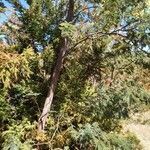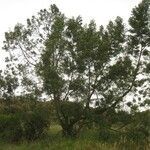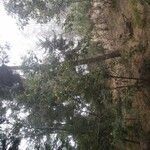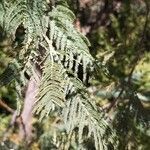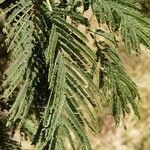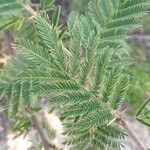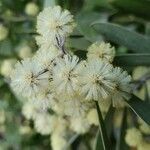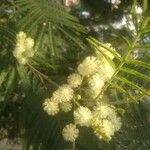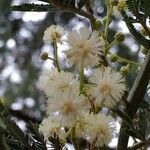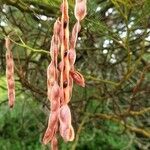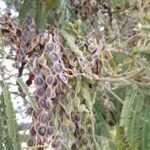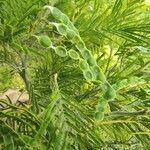Unarmed tree up to 15 m high with a conical or rounded crown; bark grey-brown to blackish, smooth or rough on very old trunks; young branchlets angular; all parts (except flowers) ± densely pubescent or puberulous, indumentum on young parts often golden. Leaves bipinnate: petiole 1-2.5 cm long, often with a gland above; rhachis usually 4-12 cm long, with numerous raised glands all along its upper surface both at and between the junctions of the pinnae pairs; pinnae 8-21 pairs; leaflets 15-70 pairs, 1.5-4 x 0.5-0.75 mm, linear-oblong, appressed-pubescent or glabrous beneath, margins usually with cilia. Inflorescences capitate, in terminal panicles. Flowers pale yellow, fragrant; peduncles 2-6 mm long. Calyx sparingly pubescent especially towards the apices of the lobes. Corolla glabrous or almost so. Pods (1.6)3-10 x 0.5-0.8 cm, jointed, almost moniliform, ± grey-puberulous, dehiscing longitudinally along one margin only, straight or slightly curved. Seeds black, ±5 x 3.5 mm, elliptic, compressed, smooth; caruncle conspicuous; areole 3.5 x 2 mm.
Tree 2–15 m. high, unarmed; crown conical or rounded; all parts (except flowers) ± densely pubescent or puberulous.. Leaves: petiole 1.5–2.5 cm. long, with a gland above; rhachis usually 4–12 cm. long, with numerous raised glands all along its upper side; pinnae (8–)12–21 pairs; leaflets usually in 16–70 pairs, linear-oblong, 1.5–4 mm. long, 0.5–0.75 mm. wide.. Flowers pale yellow, fragrant, in heads 5–8 mm. in diameter on peduncles 2–6 mm. long, panicled.. Pods (Fig. 15/21, p. 66) ± grey-puberulous, jointed, almost moniliform, dehiscing (in Australia forms with less moniliform, almost glabrous pods occur), usually about 3–10 cm. long and 0.5–0.8 cm. wide, with 3–12 joints.. Seeds black, smooth, elliptic, compressed, 5 mm. long, 3.5 mm. wide; caruncle conspicuous; areole 3.5 mm. long, 2 mm. wide.
Unarmed shrub or tree up to 24 m high. Branchlets angular, as the foliage and inflorescences densely appressed puberulous. Leaves bipinnate, petiole with one gland and numerous raised glands along the adaxial side of the rachis; leaflets 16-70 pairs, opposite, sessile, oblong-linear, 1.5-4 by 0.5-0.75 mm, broadly acute or rounded, glabrous, main vein diagonal, lateral veins inconspicuous. Inflorescences composed of pedunculate flower-glomerules, c. 5-8 mm in diameter, aggregated in racemes or panicles axillary to the upper leaves. Pod most often moniliform with 3-12 joints, grey-puberulous, dehiscent. Seeds black, smooth, elliptic, 5 by 3.5 mm, flattened.
Trees, 9-15 m tall. Branchlets angulate, gray-white tomentose. Young leaves golden tomentose, mature leaves gray pubescent; rachis not angulate; pinnae 6-30 pairs, 0.5-5.5 cm, glands at rachis of pinna insertion and elsewhere; leaflets 10-68 pairs, dense, linear, 0.7-6 × 0.4-0.8(-1) mm, margin, abaxial surface, or sometimes both surfaces pubescent. Heads globose, 6-7 mm in diam., arranged in axillary racemes or terminal panicles; peduncles 7-10 mm; rachis yellow, densely tomentose. Flowers yellowish or white. Legume black, oblong, flat, 5-10 cm × 4-5 mm, slightly constricted between seeds, pubescent. Seeds black, shiny, ovoid. Fl. Jun, fr. Aug.
A tall wattle tree. It grows 3-15 m high. It usually branches near the ground. The crown is rounded. The bark is brown and rough on the main trunks. There are fine yellow hairs on young twigs and growing tips. The leaves are dark green. The leaves are feathery. The flowers are pale yellow. They are in round heads. They are usually in clusters at the ends of branches. The fruit are straight pods. These have fine hairs. The pods are constricted between the seeds.
Tree, 5-15 m high, branchlets shallowly ridged. Bark grey-brown to blackish, smooth, later rough. Branches finely golden-hairy when young. Leaves bipinnate, dark olive-green, crowded, finely hairy, rachis 40-120 mm long, pinnae 8-21 pairs, each with 15-70 leaflet pairs. Flowers globular heads in axillary racemes, pale yellow or cream-coloured. Flowering time Aug., Sept. Pod grey-hairy, 30-100 x 5-8 mm, jointed, slightly curved, dehiscent.
Tree, up to 15 m high; unarmed. Leaves with gland at junction of each pinna pair, usually also with additional glands between pinnae pairs; leaflets 1.5-5.5 mm long. Flowers: inflorescence capitate; corolla pale yellow; Sep.-Dec. Pods ± moniliform, dehiscing longitudinally along one margin only.
Leaves: petiole 1.5-2.5 cm. long, often with a gland above; rhachis usually 4-12 cm. long, with numerous raised glands all along its upper side both at and between insertions of pinnae-pairs; pinnae (8)12-21 pairs; leaflets usually in 16-70 pairs, 1.5 x 0.5-0.75 mm., linear-oblong.
Unarmed tree, up to 15 m high. Leaflets 1.5-5.5 mm long; leaf rhachis with gland at junction of each pinna pair and usually also with additional glands between pinnae pairs. Pods moniliform. Flowers pale yellow.
Pods dehiscing along one margin only, usually c. 3-10 x 0.5-0.8 cm., with 3-12 joints, ± grey-puberulous, jointed, almost moniliform (in Australia forms with less moniliform, almost glabrous pods occur).
Tree to 15 m. Leaves bipinnate, dark green, with numerous raised glands on midvein. Flowers in globose heads, yellow. Pods flat, constricted between seeds.
Tree 2-15 m. high, unarmed; crown conical or rounded; all parts (except flowers) ± densely pubescent or puberulous.
Seeds black, 5 x 3.5 mm., smooth, elliptic, compressed; caruncle conspicuous; areole 3.5 x 2 mm.
Flowers pale-yellow, fragrant, in heads 5-8 mm. in diam. on peduncles 2-6 mm. long, panicled.
